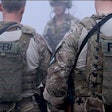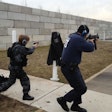On October 10, Cleveland Police responded to an active shooter inside a downtown high school. Two teachers and two students were wounded. Within five minutes of arrival, and amid the chaos of fleeing students, responding patrol officers located the body of the 14-year-old suspect on the fourth floor of the school, dead from a self-inflicted gunshot.
Cleveland PD's RAID (Rapid Action Immediate Deployment) training conducted by CPD SWAT is credited for the rapid, effective intervention. CPD, like all of America, trained first responders to intervene rapidly during active shootings. Coincidentally, while this shooting was occurring, CPD SWAT was training another group of officers in RAID tactics.
Two weeks after the school shooting, CPD conducted a debriefing involving all first responders who participated in the incident. Once the purview of SWAT, debriefings are becoming increasingly popular among non-SWAT also, especially after any high-profile incident. Coincidentally, Cleveland's police chief is a former longtime SWAT sergeant.
Learn from your Mistakes
SWAT places debriefings high on the list of learning essentials. The reason is debriefings are where we learn what went right or wrong, why, and how to correct things next time. Policing (SWAT included) is a constant learning experience, and what better way to learn than from our own experiences?
I vividly remember my introduction to the importance of critiques many years ago, by three outstanding LAPD SWAT instructors. From that time on, debriefings became our SOP, just as they have for most SWAT teams.
Lessons learned run the entire spectrum of SWAT, from strategy and tactics to technique, from commendation to criticism, from agreement to disagreement, from good to bad. But always with a single goal in mind: to improve.
Order of Business
Debriefings can be formal or informal, but all share certain commonalities. They need to be timely, relevant, structured, systematic, and focused, with a moderator controlling the content, flow, and pace of the debriefing. In other words, a debriefing officer in charge runs the debriefing, with input from all participants, in an orderly manner. For large debriefings, the OIC should assign specific officers various facets of the operation, and break the incident down into its components.
Busy teams running from mission to mission may not have time for formal debriefings after every mission. Instead, they can conduct brief, informal critiques, often en route to the next mission. Oftentimes, these informal critiques result in formal debriefings later on. What's important is that the issues be addressed and corrected while they're still fresh.
Your debriefings must be "closed door," meaning the team only. Perhaps additional debriefings can include select, "authorized outsiders," but not initially. This is your "family" business. The OIC moderator begins the debriefing with an overview of the operation. Only ONE person at a time talking (NO side conversations or debates permitted). Be systematic and ensure everyone gets a turn. Allow healthy venting and debate, but keep it civil.
Be All-Inclusive
Remember, everyone's on the same team, even when things get heated. Steer the debriefing toward a positive conclusion. Make it a unifying learning experience. If consensus on certain issues isn't possible, correct this through future training and debriefings, to ensure the team stays on the same page.
Interesting perceptions sometimes come out of debriefings, sometimes from the least likely sources. A good example is a debriefing following a nasty hostage situation we handled. A wife shot and killed her husband who was sleeping in bed, and seriously wounded her two young children and herself. She then barricaded herself in a bedroom, holding the wounded children hostage.
Time was definitely not on our side, and rapid hostage rescue was the only viable option. Soon after arrival, the entry team made a hostage rescue, freeing the children, who survived. The female shot herself again, then fought fiercely with the entry team, and died en route to the hospital.
The debriefing was especially heated coming from an unexpected source: the cover and containment team, who were frustrated over what they perceived as "taking too long" to rescue the seriously wounded children. Their underlying frustration was having to stand by, doing nothing, waiting for the entry team to make the hostage rescue. In contrast, the entry team was too busy planning and making the rescue to think about anything except the rescue. Lesson learned: always include the entire team in debriefings, including those not directly involved, because you're all on the same team.
Sometimes debriefings result in changes in tactics and or training. A prime example was a call-up debriefing debate about the role of cover and containment when a suspect comes out, running full speed, hands empty. Bogged down by weighty equipment, cover and containment is no match for a fast-moving, determined suspect. As a result, cover and containment tactics were revised.
Some debriefings are charged with emotion, especially with officer-involved shootings and incidents that result in tragedy. The initial team briefing may lead to additional team briefings, and eventually involve outside experts. But always remember, this is YOUR team, and you are family, and families are there for each other—especially during difficult times.
No doubt, many of you can cite your own examples in which debriefings led to changes in tactics. Debriefings are powerful tools, and critiquing them is a valuable learning experience for the future. Because there will always be a "next time."












